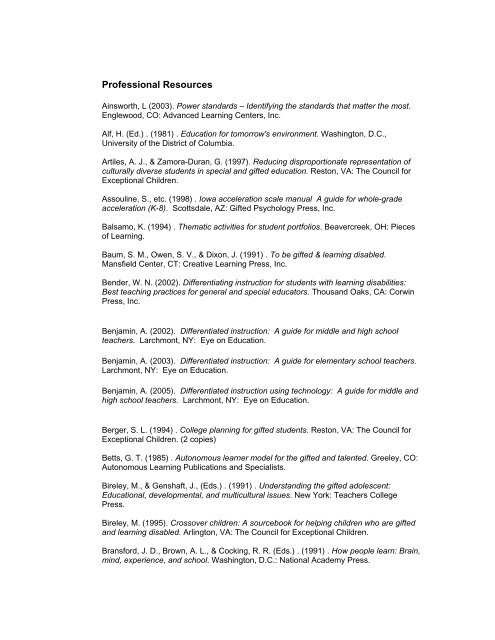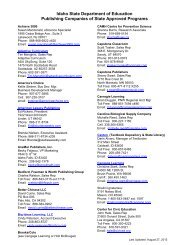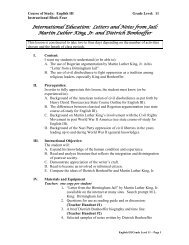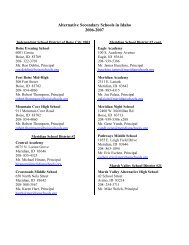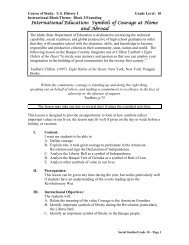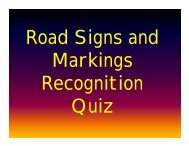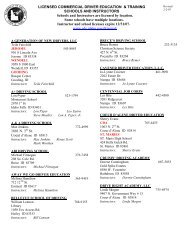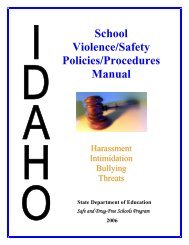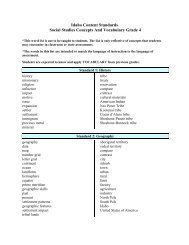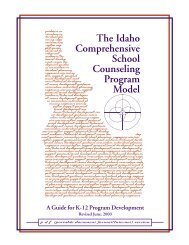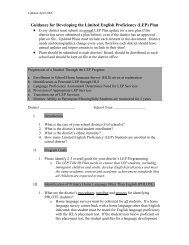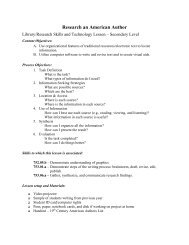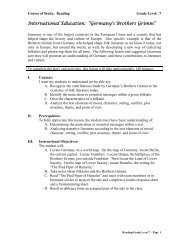Gifted and Talented Professional Resources - Idaho State ...
Gifted and Talented Professional Resources - Idaho State ...
Gifted and Talented Professional Resources - Idaho State ...
You also want an ePaper? Increase the reach of your titles
YUMPU automatically turns print PDFs into web optimized ePapers that Google loves.
<strong>Professional</strong> <strong>Resources</strong><br />
Ainsworth, L (2003). Power st<strong>and</strong>ards – Identifying the st<strong>and</strong>ards that matter the most.<br />
Englewood, CO: Advanced Learning Centers, Inc.<br />
Alf, H. (Ed.) . (1981) . Education for tomorrow's environment. Washington, D.C.,<br />
University of the District of Columbia.<br />
Artiles, A. J., & Zamora-Duran, G. (1997). Reducing disproportionate representation of<br />
culturally diverse students in special <strong>and</strong> gifted education. Reston, VA: The Council for<br />
Exceptional Children.<br />
Assouline, S., etc. (1998) . Iowa acceleration scale manual A guide for whole-grade<br />
acceleration (K-8). Scottsdale, AZ: <strong>Gifted</strong> Psychology Press, Inc.<br />
Balsamo, K. (1994) . Thematic activities for student portfolios. Beavercreek, OH: Pieces<br />
of Learning.<br />
Baum, S. M., Owen, S. V., & Dixon, J. (1991) . To be gifted & learning disabled.<br />
Mansfield Center, CT: Creative Learning Press, Inc.<br />
Bender, W. N. (2002). Differentiating instruction for students with learning disabilities:<br />
Best teaching practices for general <strong>and</strong> special educators. Thous<strong>and</strong> Oaks, CA: Corwin<br />
Press, Inc.<br />
Benjamin, A. (2002). Differentiated instruction: A guide for middle <strong>and</strong> high school<br />
teachers. Larchmont, NY: Eye on Education.<br />
Benjamin, A. (2003). Differentiated instruction: A guide for elementary school teachers.<br />
Larchmont, NY: Eye on Education.<br />
Benjamin, A. (2005). Differentiated instruction using technology: A guide for middle <strong>and</strong><br />
high school teachers. Larchmont, NY: Eye on Education.<br />
Berger, S. L. (1994) . College planning for gifted students. Reston, VA: The Council for<br />
Exceptional Children. (2 copies)<br />
Betts, G. T. (1985) . Autonomous learner model for the gifted <strong>and</strong> talented. Greeley, CO:<br />
Autonomous Learning Publications <strong>and</strong> Specialists.<br />
Bireley, M., & Genshaft, J., (Eds.) . (1991) . Underst<strong>and</strong>ing the gifted adolescent:<br />
Educational, developmental, <strong>and</strong> multicultural issues. New York: Teachers College<br />
Press.<br />
Bireley, M. (1995). Crossover children: A sourcebook for helping children who are gifted<br />
<strong>and</strong> learning disabled. Arlington, VA: The Council for Exceptional Children.<br />
Bransford, J. D., Brown, A. L., & Cocking, R. R. (Eds.) . (1991) . How people learn: Brain,<br />
mind, experience, <strong>and</strong> school. Washington, D.C.: National Academy Press.
Brown, J. (2004). Making the most of underst<strong>and</strong>ing by design. Alex<strong>and</strong>ria, VA. ASCD.<br />
Bullock, L. M., Gable, R. A., & Melloy, K. J. (2004). Differentiating curriculum <strong>and</strong><br />
instruction on behalf of students with emotional <strong>and</strong> behavioral disorders within general<br />
education settings. Arlington, VA: Council for Children with Behavioral Disorders.<br />
Burns, D. E., (1990) . Pathways to investigative skills. Mansfield Center, CT: Creative<br />
Learning Press, Inc.<br />
California Department of Education. (1979) . Education of gifted <strong>and</strong> talented pupils:<br />
Kindergarten through grade twelve. Sacramento, CA: Author.<br />
California Department of Education (1981) . Literature & story writing. Sacramento, CA:<br />
Author.<br />
Callahan, C. M. & McIntire, J. A. (1994) . Identifying outst<strong>and</strong>ing talent in American Indian<br />
<strong>and</strong> Alaska native students. Washington, D.C.: U. S. Government Printing Office. (1<br />
copy)<br />
Callahan, C.M. & Caldwell, M.S. (1997). A practitioners guide to evaluating programs for<br />
the gifted. Washington, DC: National Association for <strong>Gifted</strong> Children.<br />
Campbell, L., Campbell, B., & Dickinson, D. (1992) . Teaching <strong>and</strong> learning through<br />
multiple intelligences. Stanwood, WA: New Horizons for Learning.<br />
Chapman, C. (1993) . If the shoe fits...How to develop multiple intelligences in the<br />
classroom. Palatine, IL: Skylight Publishing, Inc.<br />
Chapman, C. & King, R. (2005). Differentiated assessment strategies: One tool doesn’t fit<br />
all. Thous<strong>and</strong> Oaks, CA: Corwin Press, Inc.<br />
Clark, B. (1988) . Growing up gifted, 3rd edition. Columbus, OH: Merrill Publishing<br />
Cline, S. (1990) . The independent learner: A guide to creative independent study,<br />
teacher’s manual. Buffalo, NY: DOK Publishers.<br />
Cline, S. (1990) . The independent learner: A student resource book for independent<br />
study. Buffalo, NY: DOK Publishers. (4 copies)<br />
Coil, C. (1992) . Motivating underachievers. Beavercreek, OH: Pieces of Learning.<br />
Coil, C. (2004). St<strong>and</strong>ards-Based activities <strong>and</strong> assessments for the differentiated<br />
classroom. Pieces of Learning.<br />
Colangelo, N., Assouline, S. G. & Gross, M. U. (2004). A nation deceived: How schools<br />
hold back America’s brightest students. Volume I. Iowa City, Iowa: The Templeton<br />
National Report on Acceleration.<br />
Colangelo, N., Assouline, S. G. & Gross, M. U. (2004). A nation deceived: How schools<br />
hold back America’s brightest students. Volume II. Iowa City, Iowa: The Templeton<br />
National Report on Acceleration.<br />
Colangelo, N. (Ed.) . Talent development: Proceedings from the 1993 Henry B. <strong>and</strong>
Jocelyn Wallace national research symposium on talent development. Dayton, OH: Ohio<br />
Psychology Press, 1994.<br />
College of William <strong>and</strong> Mary, The . Acid, acid everywhere, a problem-based unit.<br />
Dubuque, IA: Kendall/Hunt Publishing Co.<br />
College of William <strong>and</strong> Mary, The . (1998) . Journeys <strong>and</strong> destinations, a language arts<br />
unit for high-ability learners (grades 2-3). Dubuque, IA: Kendall/Hunt Publishing Co.
College of William <strong>and</strong> Mary The . (1998) . Literary reflections, a language arts unit for<br />
high-ability learners (grades 4-5). Dubuque, IA: Kendall/Hunt Publishing Co.<br />
College of William <strong>and</strong> Mary, The . (1997) . What a find, a problem-based unit. Dubuque,<br />
IA: Kendall/Hall Publishing Co.<br />
Company. Clark, B. (1997) . Growing up gifted, 5 th edition. Upper Saddle River, NJ:<br />
Prentice-Hall, Inc.<br />
Coyne, E. ( 2004). NAGC gifted program st<strong>and</strong>ards in action: A sample of programs from<br />
across the country. Washington D.C.: A Service Publication of The National Association<br />
for <strong>Gifted</strong> Children.<br />
Danielson, C. & McGreal, T. L.. Teacher evaluation to enhance professional practice.<br />
Alex<strong>and</strong>ria, Virginia: Association for Supervision <strong>and</strong> Curriculum Development.<br />
Davis, R. D. (1997). The gift of dyslexia: Why some of the smartest people can’t read...<br />
<strong>and</strong> how they can learn. New York, NY: A Perigee Book.<br />
Delisle, J. & Galbraith, J. (2002). When gifted kids don’t have all the answers: How to<br />
meet their social <strong>and</strong> emotional needs. Minneapolis, MN: Free Spirit Publishing, Inc.<br />
Diehn, G. (1998). Making books that fly, fold, wrap, hide, pop up, twist, & turn. New York,<br />
NY: Lark Books<br />
Dixon, F. & Moon, S. (2006). The h<strong>and</strong>book of secondary gifted education. Waco, TX:<br />
Prufrock Press Inc.<br />
DuFour, R., DuFour, R., Eaker, R. & Karhanek, G. (2004). Whatever it takes: How<br />
professional learning communities respond when kids don’t learn. Bloomington, IN:<br />
National Educational Service.<br />
Feldhusen, J. F., Hoover, S. M., & Sayler, M. F. (1990) . Identifying <strong>and</strong> educating gifted<br />
students at the secondary level. Unionville, NY: Trillium Press.<br />
Fiscus, L.. Leadership lessons – lessons to lead by. Reston, VA: National Association of<br />
Secondary School Principals (NASSP).<br />
Fortin, Susan (1992) . Building leaders for life – A high school leadership class<br />
curriculum. Olympia, WA: Washington Association of Secondary School Principals<br />
(WASSP).<br />
Friedrichs, T. (2001). Distinguishing characteristics of gifted students with disabilities.<br />
Waco, TX: Prufrock Press, Inc.<br />
Gallagher, J.J. (1985) . Teaching the gifted child – third edition. Newton, MA: Allyn <strong>and</strong><br />
Bacon, Inc.<br />
G<strong>and</strong>ara, P. (1995) . Over the ivy walls: The educational mobility of low-income<br />
Chicanos. Albany, NY: <strong>State</strong> University of New York Press.<br />
Gardner, H. (1983) . Frames of mind. New York: Basic Books.<br />
Garnett, K. (1994). Thinking about inclusion <strong>and</strong> learning disabilities: A teacher’s guide.<br />
Arlington, VA: The Council for Exceptional Children.
Gavin, M. K., (Ed.) . (1994) . Curricular options for high-end learning. Storrs, CT: The<br />
National Research Center on the <strong>Gifted</strong> <strong>and</strong> <strong>Talented</strong>.<br />
Georgia Department of Education. (1991) . Secondary English teachers’ resource manual<br />
for gifted students. Atlanta, GA: Author.<br />
Georgia Department of Education. (1991) . Secondary social studies teachers’ resource<br />
manual for gifted students. Atlanta, GA: Author.<br />
Gibbs, J. (1994) . Tribes: A new way of learning together. Santa Rosa, CA: Center<br />
Source Publications.<br />
Goleman, D. (1995). Emotional Intelligence: Why it can matter more than IQ. New York,<br />
NY; Bantam Books.<br />
Hall, R. E., & Clements, S. (undated) . Hey! Hey! What about me? Exploring giftedness in<br />
terms of bilingual <strong>and</strong> minority gifted. Tempe, AZ: Tempe Elementary School District #3.<br />
Halsted, J. (2002). Some of my best friends are books. Scottsdale, AZ: Great Potential<br />
Press.<br />
Heacox, D. (2002). Differentiating instruction in the regular classroom: How to reach <strong>and</strong><br />
teach all learners, grades 3-12. Minneapolis, MN: Free Spirit Publishing, Inc.<br />
Higgins, J., McConnell, K., Patton, J. R. & Ryser, G. R. (2003). Practical ideas that really<br />
work for students with dyslexia, <strong>and</strong> other reading disorders. Austin, TX: Pro-Ed.<br />
Hilliard, S., & Sattler, J. (1987) . Nuts <strong>and</strong> bolts: A practical guide for implementing a<br />
junior high/middle school enrichment program. Mansfield Center, CT: Creative Learning<br />
Press, Inc.<br />
Hirsch, S. P. (1979) . Young, gifted, & h<strong>and</strong>icapped. Washington, D.C.: U.S. Office of<br />
Education.<br />
Hopfenberg, W. S., (Ed.) . (1993) . The accelerated schools: Resource guide. San<br />
Francisco: Jossey-Bass.<br />
Ihrig, D., & Baldus, C. (2001) . <strong>Gifted</strong> voices from rural America. Iowa City, IA: The<br />
University of Iowa.<br />
Johnson, N. L. (1989) . The faces of gifted. Beavercreek, OH: Pieces of Learning.<br />
Kaplan, S., & Cannon, M. W. (2001). Lessons from the middle: High-end learning for<br />
middle school students. Waco, TX: Prufrock Press, Inc.<br />
Karnes, F. & Bean, S. (2005). Methods <strong>and</strong> materials for teaching the gifted. Second<br />
edition. Waco: Prufrock Press, Inc.<br />
Karnes, F. A., & Marquardt, R. G. (2000) . <strong>Gifted</strong> children <strong>and</strong> legal issues an update.<br />
Scottsdale, AZ: <strong>Gifted</strong> Psychology Press. (25)<br />
Karnes, F. A., & Marquardt, R. G. (1991) . <strong>Gifted</strong> children <strong>and</strong> the law: Mediation, due<br />
process <strong>and</strong> court cases. Dayton, OH: Ohio Psychology Press. (26)<br />
Karnes, F. A., & Bean, S. M. (1993) . Girls <strong>and</strong> young women leading the way.<br />
Minneapolis: Free Spirit Publishing, Inc.
Kay, Kiesa (2000). Uniquely gifted: Identifying <strong>and</strong> meeting the needs of the twiceexceptional<br />
student. Gilsum, NH: Avocus Publishing, Inc.<br />
Kay, K. (Ed.) . (2000) . Uniquely gifted: Identifying <strong>and</strong> meeting the needs of the twiceexceptional<br />
student. Gilsum, NH: Avocus Publishing, Inc.<br />
Kerr, B. A. (1985) . Smart girls gifted women. Dayton: Ohio Psychology Press.<br />
Kimeldorf, M. (1994) . Creating portfolios for success in school, work, <strong>and</strong> life.<br />
Minneapolis: Free Spirit Publishing.<br />
Kimeldorf, M. (1994) . A teacher’s guide to creating portfolios for success in school, work,<br />
<strong>and</strong> life. Minneapolis: Free Spirit Publishing.<br />
Kincher, J. (1988) . Dreams can help: A journal guide to underst<strong>and</strong>ing your dreams <strong>and</strong><br />
making them work for you. Minneapolis: Free Spirit Publishing, Inc.<br />
Kingore, B. (1993) . Portfolios: Enriching <strong>and</strong> assessing all students & identifying the<br />
gifted grades K-6. Des Moines: Leadership Publishers, Inc. (2 copies)<br />
Kovalik, S., & Olsen, K. (1993) . ITI: The model--integrated thematic instruction. Oak<br />
Creek, AZ: Books for Educators.<br />
Kurpius, S.; Kerr, B., & Harkins, A. (2005). H<strong>and</strong>book for counseling girls <strong>and</strong> women: ten<br />
years of gender equity research at Arizona <strong>State</strong> University. Vol. 1: Talent, risk <strong>and</strong><br />
resiliency. & Vol 2: Talent development. Mesa, AZ: Nueva Science Press.<br />
L<strong>and</strong>rum, M. S., Callahan, C. M. & Shaklee, B. D. (2001). Aiming for excellence: <strong>Gifted</strong><br />
program st<strong>and</strong>ards. Annotations to the NAGC Pre-K-Grade 12 gifted program st<strong>and</strong>ards.<br />
Washington D.C.: The National Association for <strong>Gifted</strong> Children.<br />
Lauren, J. (1997) . Succeeding with LD. Minneapolis: Free Spirit Publishing.<br />
Lazear, D. (1994) . Multiple intelligence approaches to assessment. Tucson, AZ: Zephyr<br />
Press.<br />
Levy, S. (1996). Starting from scratch: One classroom builds its own curriculum.<br />
Portsmouth, NH: Heinemann.<br />
Lovecky, D. V. (2004). Different minds: <strong>Gifted</strong> children with AD/HD, Asperger Syndrome,<br />
<strong>and</strong> other learning deficits. Philadelphia, PA: Jessica Kingsley Publishers.<br />
Maker, C. J. (Ed.) . (1989) . Critical issues in gifted education. Austin, TX: Pro-Ed.<br />
Maker, C. J., & King, M. A. (1996) . Nurturing giftedness in young children. Reston, VA:<br />
The Council for Exceptional Children.<br />
Marzano, R. J. (2000). Transforming classroom grading. Alex<strong>and</strong>ria, VA: Association for<br />
Supervision <strong>and</strong> Curriculum Development.<br />
Marzano, R. J., Pickering, D. J. & Pollock, J. E. (2001). Classroom instruction that works:<br />
Research-based strategies for increasing student achievement. Alex<strong>and</strong>ria, VA:<br />
Association for Supervision <strong>and</strong> Curriculum Development.<br />
Marzano, R. J., Norford, J. S., Paynter, D. E., Pickering, D. J. & Gaddy, B. B. (2001). A
h<strong>and</strong>book for classroom instruction that works. Alex<strong>and</strong>ria, VA: Association for<br />
Supervison <strong>and</strong> Curriculum Development.<br />
Mass, L. (1980) . Kids working with kids. New York: Trillium Press.<br />
McMurchie, S. (2003). Underst<strong>and</strong>ing my learning differences. Verona, WI: IEP<br />
<strong>Resources</strong>.<br />
Moeller, V. & Moeller, M. (2002). Socratic seminars <strong>and</strong> literature circles for middle <strong>and</strong><br />
high school English. Larchmont, NY: Eye on Education.<br />
Naglieri, J. A. (1985) . Matrix analogies test--short form. New York: Harcourt Brace<br />
Jovanovich.<br />
Neihart, M., Reis, S., Robinson, N. & Moon, S. (2002). The social <strong>and</strong> emotional<br />
development of gifted children: What do we know? Waco, TX: Prufrock Press, Inc.<br />
Northey, S. (2005). H<strong>and</strong>book on differentiated instruction for middle <strong>and</strong> high schools.<br />
Larchmont, NY: Eye on Education, Inc.<br />
Nunley, K. (2006). Differentiating the high school classroom. Thous<strong>and</strong> Oaks: Corwin<br />
Press.<br />
Ohio Department of Education. (1992) . Model for the identification of: Creative-thinking<br />
ability. Columbus, OH: Author.<br />
Ohio Department of Education. (1992) . Models for providing a continuum of services to:<br />
<strong>Gifted</strong> students. Columbus, OH: Author.Ohio Department of Education.<br />
Ohio Department of Education. (1992) Models for improving the delivery of services to:<br />
<strong>Gifted</strong> students in the areas of visual <strong>and</strong> performing arts. Columbus, OH: Author. (2<br />
copies)<br />
Piirto, J.P. (1999) . <strong>Talented</strong> children <strong>and</strong> adults – their development <strong>and</strong> education, 2nd<br />
edition). Upper Saddle River, NJ: Merrill/Prentice Hall.<br />
Popham, W. J. (2004). America’s “failing” schools – How parents <strong>and</strong> teachers can cope<br />
with no child left behind. New York, NY: RoutledgeFalmer.<br />
Purcell, J. H. (2006). Designing services <strong>and</strong> programs for high-ability learners.<br />
Thous<strong>and</strong> Oaks, CA: Corwin Press.<br />
Reeves, D. B. (2002). The daily disciplines of leadership: How to improve student<br />
achievement, staff motivation, <strong>and</strong> personal organization. San Francisco, CA: Jossey-<br />
Bass.<br />
Reeves, D. B. (2002). The leader’s guide to st<strong>and</strong>ards: A blueprint for educational equity<br />
<strong>and</strong> excellence. San Francisco, CA: Jossey-Bass.<br />
Reeves, D. B. (2002). Reason to write: Help your child succeed in school <strong>and</strong> in life<br />
through better reasoning <strong>and</strong> clear communication. New York, NY: Kaplan Publishing.<br />
Reeves, D. B. (2000). Accountability in action: A blueprint for learning organizations.<br />
Denver, CO: Center for Performance Assessment.
Reis, S. Essential Readings in <strong>Gifted</strong> Education. 12 Volume collection of articles from<br />
<strong>Gifted</strong> Child Quarterly.<br />
Volume 1: Definitions <strong>and</strong> Conceptions of giftedness<br />
Volume 2: Identification of Students for <strong>Gifted</strong> <strong>and</strong> <strong>Talented</strong> Program<br />
Volume 3: Grouping <strong>and</strong> Acceleration Practices in <strong>Gifted</strong> Education<br />
Volume 4: Curriculum for <strong>Gifted</strong> <strong>and</strong> <strong>Talented</strong> Students<br />
Volume 5: Differentiation for <strong>Gifted</strong> <strong>and</strong> <strong>Talented</strong> Students<br />
Volume 6: Culturally Diverse <strong>and</strong> Underserved Populations of <strong>Gifted</strong> Students<br />
Volume 7: Twice-Exceptional <strong>and</strong> Special Populations of <strong>Gifted</strong> Students<br />
Volume 8: Social/Emotional Issues, Underachievement, <strong>and</strong> Counseling of <strong>Gifted</strong><br />
<strong>and</strong> <strong>Talented</strong> Students<br />
Volume 9: Artistically <strong>and</strong> Muscially <strong>Talented</strong> Students<br />
Volume 10: Creativity <strong>and</strong> <strong>Gifted</strong>ness<br />
Volume 11: Program Evaluation in <strong>Gifted</strong> Education<br />
Volume 12: Public Policy in <strong>Gifted</strong> Education<br />
Reis, S. M., Burns, D. E., & Renzulli, J. S. (1992) . Curriculum compacting: A guide for teachers.<br />
Mansfield Center, CT: Creative Learning Press.<br />
Reis, S. M., Burns, D. E., & Renzulli, J. S. (1992) . Facilitator’s guide to help teachers compact<br />
curriculum. Mansfield Center, CT: Creative Learning Press.<br />
Reis, S. M., & Renzulli, J. S. (1985) .The secondary triad model: A practical plan for implementing<br />
gifted programs at the junior <strong>and</strong> senior high levels. Mansfield Center, CT: Creative Learning<br />
Press, Inc.<br />
Renzulli, J. S., & Reis, S. M. (1991) . The complete triad trainer’s inservice manual. Mansfield<br />
Center, CT: Creative Learning Press, Inc.<br />
Renzulli, J. S. (1977) . The enrichment triad model: A guide for developing defensible programs<br />
for the gifted <strong>and</strong> talented. Mansfield Center, CT: Creative Learning Press, Inc.<br />
Renzulli, J. S., & Smith, L. H. (1979) . A guidebook for developing individualized education<br />
programs (IEP) for gifted <strong>and</strong> talented students. Mansfield Center, CT: Creative Learning Press,<br />
Inc.<br />
Renzulli, J. S. (1986) . Systems <strong>and</strong> models for developing programs for the gifted <strong>and</strong> talented.<br />
Mansfield Center, CT: Creative Learning Press, Inc.<br />
Robertson, S.C. (1997) . <strong>Gifted</strong> <strong>and</strong> talented education program curriculum, leadership<br />
laboratory, grades 2-6 - gifted. Boise, ID: Independent School District of Boise City.<br />
Roets, L.F. (1997) . Leadership skills training program ages 8-18 (8 th edition). Des Moines,<br />
IA:Leadership Publishers Inc.<br />
Roets, L.R. (2000) . Leadership for ages 4-8: identification & talent development (2 nd edition). Des<br />
Moines, IA: Leadership Publishers, Inc.<br />
Roets, L.F. (2000). St<strong>and</strong>ards & benchmarks for education of gifted & talented high-ability<br />
students, k-12. Des Moines, IA: Leadership Publishers Inc.<br />
Rogers, K. B. (2002. Re-forming gifted education: How parents <strong>and</strong> teachers can match the<br />
program to the child. Scottsdale, AZ: Great Potential Press, Inc.<br />
Rogers, L.T. (1991) . How to start a leadership class. Reston, VA: National Association of
Secondary School Principals.<br />
Ruf, D. (2005). Losing our minds: <strong>Gifted</strong> children left behind. Scottsdale, AZ: Great Potential<br />
Press.<br />
Schmoker, M. (2001). The results fieldbook: Practical strategies from dramatically improved<br />
Schools. Alex<strong>and</strong>ria, VA: Association for Supervision <strong>and</strong> Curriculum Development.<br />
Schwartz, M.K., Axtman, K.M., Freeman, F.H. (1998) . Leadership education – a source book of<br />
courses <strong>and</strong> programs (7 th edition). Greensboro, NC: Center for Creative Leadership.<br />
Schwartz, M.K., Axtman, K.M., Freeman, F.H. (1998) . Leadership resources – a guide to training<br />
<strong>and</strong> development tools (7 th edition). Greensboro, NC: Center for Creative Leadership.<br />
Silverman, L. (2002). Upside-down brilliance: The visual-spatial learner. Denver, CO: DeLeon<br />
Publishing.<br />
Sloane, P. (1992) . Lateral thinking puzzlers. New York: Sterling Publishing Co., Inc.<br />
Sloane, P., & MacHale, D. (1993) . Challenging lateral thinking puzzles. New York: Sterling<br />
Publishing Co., Inc.<br />
Sloane, P., & MacHale, D. (1994) . Great lateral thinking puzzles. New York: Sterling Publishing<br />
Co., Inc.<br />
Slocumb, P. D. & Payne, R. K. (2000) . Removing the mask: <strong>Gifted</strong>ness in poverty. Highl<strong>and</strong>s,<br />
TX: RFT Publishing.<br />
Smutny, J. F. (2004). Differentiating for the young child. Thous<strong>and</strong> Oaks, CA: Corwin Press,<br />
Inc.<br />
Smutny, J. F. (2003). Designing <strong>and</strong> developing programs for gifted students. Thous<strong>and</strong> Oaks,<br />
CA: Corwin Press, Inc.<br />
Smutny, J. F. (Ed.) (1998) . The young gifted child: Potential <strong>and</strong> promise, an anthology. Creskill,<br />
NJ: Hampton Press, Inc.<br />
Solmon, L. C., Agam, K. F. & Schiff, T. W. (2004). Improving student achievement: reforms that<br />
work. Greenwich, CT: Milken Family Foundation.<br />
Sousa, D. (2003). How the gifted brain learns. Thous<strong>and</strong> Oaks, CA: Corwin Press, Inc.<br />
Southern, W. T., & Jones, E. D., (Eds.) . (1991) . The academic acceleration of gifted children.<br />
New York: Teachers College Press.<br />
Stepanek, J. (1999). The Inclusive Classroom Meeting the Needs of <strong>Gifted</strong> Students:<br />
Differentiating Mathematics <strong>and</strong> Science Instruction IT’S JUST GOOD TEACHING. Portl<strong>and</strong>,<br />
OR: Northwest Regional Educational Laboratory.<br />
Stiggins, R.J. (2001) . Student-Involved Classroom Assessment (3 rd Ed). Upper Saddle River,<br />
NJ/Columbus, OH: Merrill Prentice Hall.<br />
Thompson, L. & Luce, T. (2005). Do what works: How proven practices can improve America’s<br />
public schools. Dallas, TX: Ascent Education Press.
Tomlinson, C. (2003). Fulfilling the promise of the differentiated classroom. Alex<strong>and</strong>ria, VA:<br />
ASCD.<br />
Tomlinson, C., Kaplan, S., Purcell, J., Leppien, J., Burns, D., Strickl<strong>and</strong>, C. (2006). The parallel<br />
curriculum in the classroom – Book 1. Essays for application across the content areas K-12.<br />
Thous<strong>and</strong> Oaks: Corwin Press.<br />
Tomlinson, C.; McTighe, J. (2006). Integrating differentiated instruction & underst<strong>and</strong>ing by<br />
design. Alex<strong>and</strong>ria, VA: ASCD.<br />
Tomlinson, C.; Strickl<strong>and</strong>, C. (2005). Differentiation in Practice: A resource guide for<br />
differentiating curriculum. Alex<strong>and</strong>ria, VA: ASCD.<br />
Tomlinson, C. A. (2001). How to differentiate instruction in mixed-ability classrooms. Alex<strong>and</strong>ria,<br />
VA: Association for Supervision <strong>and</strong> Curriculum Development.<br />
Tomlinson, C. A., Kaplan, S. N., Renzulli, J. S., Purcell, J., Leppien, J. & Burns, D. (2002). The<br />
parallel curriculum: A design to develop high potential <strong>and</strong> challenge high-ability learners.<br />
Thous<strong>and</strong> Oaks, CA: Corwin Press, Inc.<br />
Tomlinson, C. A. (1999) . The differentiated classroom: Responding to the needs of all learners.<br />
Alex<strong>and</strong>ria, VA: Association for Supervision <strong>and</strong> Curriculum Development.<br />
Tomlinson, C.A. (2000) . Leadership for differentiating schools & classrooms, Alex<strong>and</strong>ria, VA:<br />
Association for Supervision <strong>and</strong> Curriculum Development.<br />
Tuttle, F. B., Jr., et al. (1990) . Characteristics <strong>and</strong> identification of gifted <strong>and</strong> talented students,<br />
3rd edition. Washington, D.C.: National Education Association.<br />
Vail, P. L. (1989). Smart kids with school problems: Things to know & ways to help. New York,<br />
NY: The Penguin Group.<br />
Villa, R., Thous<strong>and</strong>, J. & Nevin, A. A guide to co-teaching: Practical tips for facilitating student<br />
learning. Thous<strong>and</strong> Oaks, CA: Corwin Press.<br />
Wagner, S. (1999). Inclusive progamming for elementary students with autism. Arlington, TX:<br />
Future Horizons.<br />
Wagner, S. (1999). Inclusive programming for middle school students with autism/asperger's<br />
syndrome. Arlington, TX: Future Horizons.<br />
Waterman, S. (2007). The democratic differentiated classroom. Larchmont, NY: Eye on<br />
Education.<br />
Webb, J., Amend, E., Webb, N., Goerss, J., Beljan, P., Olenchak, F. Misdiagnosis <strong>and</strong> dual<br />
diagnoses of gifted children <strong>and</strong> adults. Scottsdale, AZ: Great Potential Press.<br />
Webb, J. T., & DeVries, A. R. (1993) . Able, bright, creative: For facilitators of SENG model<br />
guided discussion groups. Dayton, OH: Ohio Psychology Press.<br />
Whitaker, T. (2004). What great teachers do differently: 14 things that matter most. Larchmont,<br />
NY: Eye on Education.<br />
Whitmore, J. R., & Maker, C. J. (1985) . Intellectual giftedness in disabled persons. Salem, MA:<br />
Aspen Systems Corporation.
Wiggins, G. & McTighe, J. (2004). Underst<strong>and</strong>ing by design. Alex<strong>and</strong>ria, VA. ASCD.<br />
Wiggins, G. & McTighe, J. (2004). Underst<strong>and</strong>ing by design: <strong>Professional</strong> development<br />
workbook. Alex<strong>and</strong>ria, VA. ASCD.<br />
Winebrenner, S. (1992) . Teaching gifted kids in the regular classroom. Minneapolis: Free Spirit<br />
Publishing, Inc. (15 copies) (2,4,8,10,11,13,14,16,17,18,19,21,22,23,25)<br />
Winebrenner, S. (1996) . Teaching kids with learning difficulties in the regular classroom.<br />
Minneapolis: Free Spirit Publishing, Inc.<br />
Wormeli, R. (2006). Fair isn’t always equal: Assessing <strong>and</strong> grading in the differentiated<br />
classroom. Stenhouse Publishers.


